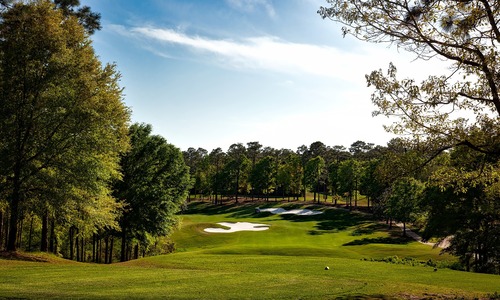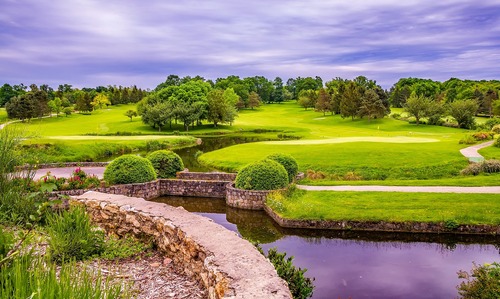At Unique Golf Gears, we are committed to providing you with comprehensive information about golf courses, their yardage, and the concept of par. In this article, we aim to offer valuable insights that will help you gain a better understanding of golf course yardage and the significance of the par score. Let’s dive into the details!
What is Golf Course Yardage?
Golf course yardage refers to the total distance from the tee box to the green of each hole on a golf course. It plays a crucial role in determining the difficulty and challenge of the course. The yardage varies from one course to another, as each course has its unique layout and design. It is essential to understand that the yardage of a golf course does not solely dictate its difficulty level.
Factors Influencing Golf Course Yardage
The yardage of a golf course is influenced by several factors, including:

Course Design
The architect of the golf course determines the layout, which includes the positioning of hazards, doglegs, and elevation changes. These design elements can significantly impact the yardage.
One of the greatest golf course architects of all time was William P Bell. Credited for being the original designer for 28 golf courses in the US.
Tee Placement
Golf courses often have multiple sets of tees, each offering different yardages. This allows players of various skill levels to enjoy the game. The tee placement chosen for a round can affect the overall yardage of the course.
Elevation Changes
Golf courses built on hilly terrains may have significant elevation changes, resulting in longer or shorter distances between tees and greens. Uphill shots require more club selection and power, while downhill shots may allow players to hit the ball farther.
Environmental Factors
External elements such as wind, temperature, and humidity can affect the playing conditions and subsequently impact the effective yardage of a golf course. These factors need to be considered while analyzing the yardage.
Understanding Par in Golf
Now that we have covered the basics of golf course yardage, let’s explore the concept of par and its significance in the game.

What is Par?
In golf, par is the predetermined number of strokes that a skilled golfer is expected to require to complete a hole. It serves as a benchmark for measuring performance and comparing scores. Par values are typically set based on the length and difficulty of each hole, but they can vary from one course to another.
Factors Influencing Par
Par values are determined by considering the following factors:
Yardage
The length of a hole influences its par value. Longer holes generally have higher par values, while shorter holes have lower par values. However, other factors like hazards and green complexity also contribute to the par determination.
Hazards
Hazards such as water bodies, bunkers, and out-of-bounds areas on a hole can increase the difficulty level. Such hazards often lead to higher par values as they pose challenges that golfers must navigate effectively.
Green Complexity
The complexity of the putting green, including its undulations and slopes, can impact the difficulty of the hole. Greens with intricate designs may lead to higher par values.
Are All Golf Courses Par 72?

While the par 72 is a commonly seen standard for golf courses, it is important to note that not all golf courses adhere to this specific par value. Golf courses can have varying par values depending on their design, layout, and intended level of difficulty. Par values can range from par 3 for shorter holes to par 5 for longer and more challenging ones.
Factors such as the number and placement of hazards, the length of the fairways, and the complexity of the greens all contribute to determining the par value of a golf course. Therefore, it is inaccurate to assume that all golf courses are par 72.
Final Thoughts
In conclusion, understanding golf course yardage and the concept of par is essential for any golfer seeking to improve their game. Golf course yardage encompasses the distance from tee to green, influenced by factors like course design, tee placement, elevation changes, and environmental conditions. Par, on the other hand, represents the expected number of strokes a skilled golfer should take to complete a hole, considering factors such as yardage, hazards, and green complexity.
By providing comprehensive information on these topics, we aim to equip you with valuable knowledge that will enhance your understanding of golf courses and help you make informed decisions on the course.
Remember, improving your golf game involves a combination of skill, strategy, and understanding the intricacies of each course you play. Armed with knowledge about golf course yardage and the significance of par, you can approach your rounds with confidence and make more informed decisions to optimize your performance.
We hope that this comprehensive article has provided you with valuable insights into golf course yardage and the concept of par. At Unique Golf Gears, we remain committed to delivering high-quality content that empowers you with the knowledge you need to excel in your golfing journey. Happy golfing!
FAQs
Q: What is golf course yardage?
A: Golf course yardage refers to the total distance from the tee box to the green of each hole on a golf course. It helps determine the difficulty and challenge of the course. But it’s important to note that yardage alone doesn’t solely dictate the difficulty level.
Q: What factors influence golf course yardage?
A: Several factors influence golf course yardage, including the course design, tee placement, elevation changes, and environmental factors. The architect determines the course layout, which includes hazards, doglegs, and elevation changes. Tee placement varies, providing different yardages for players of various skill levels. Elevation changes on hilly terrains affect distances between tees and greens. Additionally, external factors such as wind, temperature, and humidity impact the effective yardage.
Q: What is par in golf?
A: In golf, par is the predetermined number of strokes that a skilled golfer is expected to require to complete a hole. It serves as a benchmark for measuring performance and comparing scores. Par values are typically set based on the length and difficulty of each hole but can vary between courses.
Q: What factors influence par values?
A: Par values are influenced by various factors, including yardage, hazards, and green complexity. Longer holes generally have higher par values, while shorter holes have lower par values. However, hazards such as water bodies, bunkers, and out-of-bounds areas can increase the difficulty level, leading to higher par values. Additionally, the complexity of the putting green, including undulations and slopes, can also impact the difficulty and contribute to determining the par value.
Q: Are all golf courses par 72?
A: No, not all golf courses are par 72. While par 72 is a commonly seen standard for golf courses, the par value can vary depending on the design, layout, and intended level of difficulty. Par values can range from par 3 for shorter holes to par 5 for longer and more challenging ones. Factors such as hazards, fairway length, and green complexity all play a role in determining the par value of a golf course.
We hope these frequently asked questions have provided clarity and addressed any uncertainties regarding golf course yardage and par. For more detailed information and to further enhance your golfing knowledge, feel free to explore our comprehensive article. At Unique Golf Gears, we are committed to delivering top-quality content to help you excel in your golfing journey.





